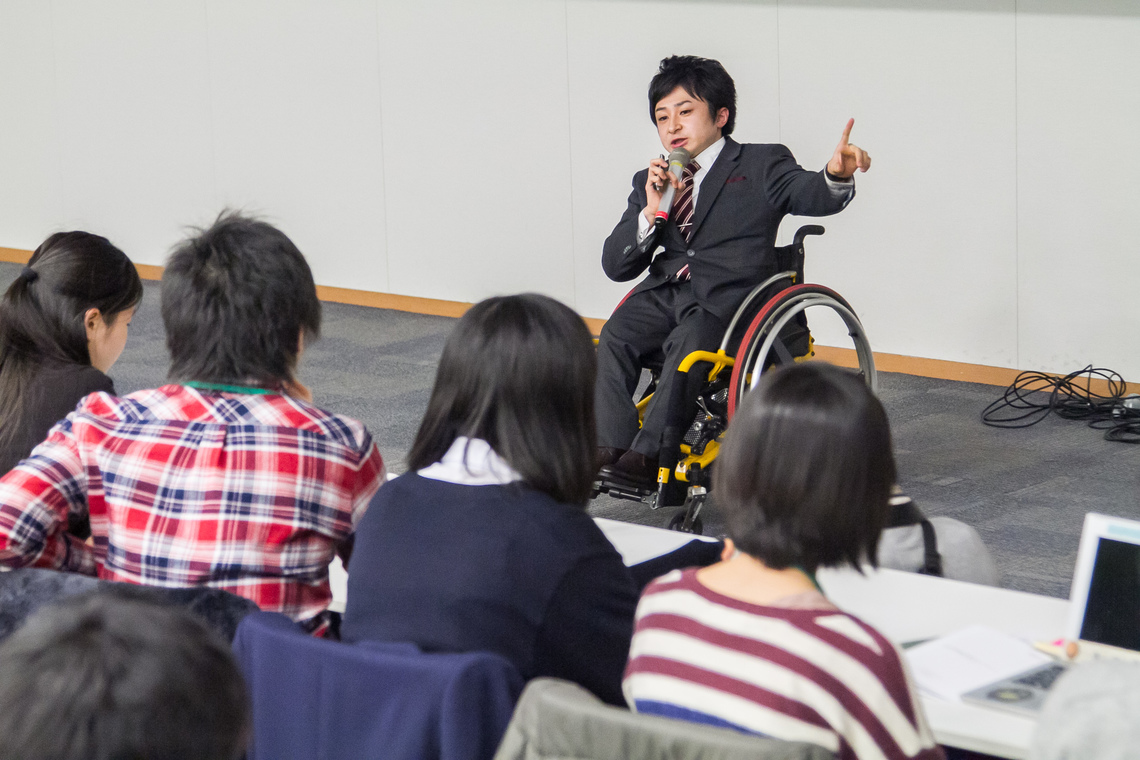Note: This website was automatically translated, so some terms or nuances may not be completely accurate.
Toshiya Kakiuchi (President, Mirairo) "The 40 Million Market Created by Universal Design"

Toshiya Kakiuchi
Mirairo Co., Ltd.
Universal design refers to the design of facilities, products, and information that can be used by everyone, regardless of differences in culture, language, nationality, age, gender, or whether they have disabilities or varying abilities. Mirairo President Kakiuchi, who views universal design as a "business market" and is developing various new ventures, passionately discussed its potential as a market.
Entrepreneurship connects everyone to their dreams
I started a business with friends during my sophomore year of university. Initially, we weren't thinking about the kind of universal design consulting business we have today. The main idea was that if we started a business, we could stand on the same playing field as able-bodied people. That was the motivation. Due to a congenital bone disease, I underwent repeated surgeries and rehabilitation, but ultimately, I was forced to live in a wheelchair. To like myself and gain confidence, I wanted a field where I could compete on equal terms.
Through trial and error, I participated in a business plan contest. My barrier-free related business plans were highly evaluated multiple times, making it clear to me that such businesses and services are precisely what society needs now. A business that leverages disability and its experiences, often perceived negatively. That was the path to spreading universal design much more widely throughout society. Being in a wheelchair, with my eye level at 106 centimeters, means I notice things others might miss. I realized my dream of starting a business was also everyone's dream.
"Everyone" refers to those who find going out inconvenient. There are approximately 30 million elderly people, about 8 million people with disabilities, and roughly 3.15 million children under three using strollers. Combined, that's over 40 million people. This represents a market comprising about 30% of Japan's population. If we include parents, children, siblings, friends, and colleagues who accompany them, the market size becomes even larger.
The Persistent "Assumption Barrier"
In reality, Japan is a world leader in barrier-free design. Japan developed tactile paving over half a century ago, and approximately 90% of stations with over 3,000 daily users have advanced barrier-free facilities. However, even facilities built in compliance with laws and ordinances often prove difficult to use in practice. This is the so-called "perceived barrier-free." For example, tactile paving is sometimes laid in a way that guides users toward ramps. While ramps are appreciated by wheelchair users and the elderly, some visually impaired individuals prefer using stairs rather than taking a detour.
There are also cases that raise questions from an economic rationality perspective. Currently, lodging facilities with 50 or more rooms must have at least one barrier-free room. Yet, some of these rooms are so heavily equipped with handrails throughout that you might wonder, "Is this a hospital?" This stems from a vague assumption that "this must be convenient for people with disabilities."

2020: The True Value of Universal Design Will Be Tested
Why do we make things barrier-free? For whom do we implement universal design? That is the question being asked now. Ignorance or indifference won't do, but excess is meaningless too. Traditionally, one major reason corporate barrier-free and universal design initiatives didn't fully take root was that they remained confined to the realm of CSR (Corporate Social Responsibility). However, in today's business landscape, addressing barrier-free and universal design has become a "reason for being chosen" by the 30% of the population comprising people with disabilities, the elderly, and parents of children.
It goes without saying that this importance extends beyond just the physical aspects like buildings and facilities; the service and other intangible aspects are equally crucial. For example, when a wheelchair user visits a restaurant, the staff's first action might be to remove the chairs from the table to make space for the wheelchair. However, some people prefer to move to a regular chair because sitting in a wheelchair for extended periods can be tiring.
One service Mirairo provides is the "Universal Manners Certification." One of its goals is to help companies and organizations understand what people with disabilities and the elderly truly need. Simultaneously, it aims to show that eliminating "I don't know," "I don't understand," and "I can't do it" provides reassurance to people with disabilities, the elderly, and their families, leading to their becoming loyal customers. This also responds to the contemporary need to value time spent together as a family.
Last June, Mirairo formed a business partnership with Dentsu Inc. Together with Dentsu Inc. internal task force, the 'Dentsu × Mirairo UD Business Project,' we have made proposals and are beginning to see results. We are also jointly developing support tools for UD product and service development. We consider last year, when the 2020 Tokyo Olympics and Paralympics were officially awarded, to be the 'Year One of Universal Design.' As the world's attention increasingly focuses on Japan, the capabilities of Japanese universal design will be put to the test—from the nature of facilities and equipment to the level of hospitality extended to people with disabilities and the elderly.
Mirairo's philosophy is "Barrier Value"—viewing disability not as a disadvantage, but as a value. That very era is now right around the corner.
Was this article helpful?
Newsletter registration is here
We select and publish important news every day
For inquiries about this article
Author

Toshiya Kakiuchi
Mirairo Co., Ltd.
President
Born in 1989. Founded Mirairo while attending university. Developed planning and information services related to universal design. Received the Grand Prize at the 2013 "Everyone's Dream AWARD 3." Selected for Nikkei Business's "THE 100 - 2014 Japan's Leading Figures" in January of this year.